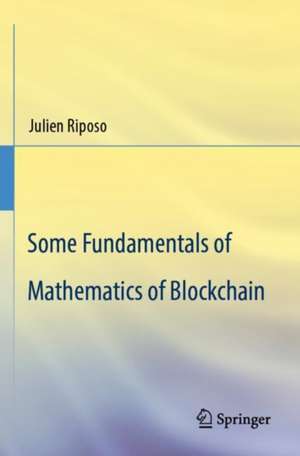Some Fundamentals of Mathematics of Blockchain
Autor Julien Riposoen Limba Engleză Paperback – 7 iun 2024
First, the basis of a blockchain is set: block, transaction contents, block header, Merkle tree, nonce, Proof-of-Work. Connections with elliptic curves and cryptographic signatures are made.
Second, the book ties this with a Graph and Matrix Theories approach and models the peer-to-peer relationship through the Bitcoin Network.
Third, it is proposed further modelling, notably around halving, optimal storing, or diffusion of information, which are consequences of the mathematical foundation. The notion of Entropy of Privacy and the Particles model are introduced. Finally, the mathematical statements therein are proven and essential reminders can be found before each section, so the content can be accessible from a graduate level.
| Toate formatele și edițiile | Preț | Express |
|---|---|---|
| Paperback (1) | 672.30 lei 38-44 zile | |
| Springer Nature Switzerland – 7 iun 2024 | 672.30 lei 38-44 zile | |
| Hardback (1) | 690.27 lei 22-36 zile | +18.71 lei 6-12 zile |
| Springer Nature Switzerland – 7 iun 2023 | 690.27 lei 22-36 zile | +18.71 lei 6-12 zile |
Preț: 672.30 lei
Preț vechi: 884.61 lei
-24% Nou
Puncte Express: 1008
Preț estimativ în valută:
128.69€ • 139.83$ • 108.17£
128.69€ • 139.83$ • 108.17£
Carte tipărită la comandă
Livrare economică 16-22 aprilie
Preluare comenzi: 021 569.72.76
Specificații
ISBN-13: 9783031313257
ISBN-10: 3031313259
Pagini: 150
Ilustrații: XIII, 150 p. 1 illus.
Dimensiuni: 155 x 235 mm
Ediția:2023
Editura: Springer Nature Switzerland
Colecția Springer
Locul publicării:Cham, Switzerland
ISBN-10: 3031313259
Pagini: 150
Ilustrații: XIII, 150 p. 1 illus.
Dimensiuni: 155 x 235 mm
Ediția:2023
Editura: Springer Nature Switzerland
Colecția Springer
Locul publicării:Cham, Switzerland
Cuprins
I. Blockchain and the Underlying Mathematics.- II. Mathematical Settings of the Blockchain.- III. Digital Signature.- IV. Blockchain Contributors: the Network of Users.- V. Halving and Cycles Theorem.- VI. On Improving the Merkle Trees: the ����-Trees.- VII. Entropy of Peer-to-Peer Network.- VIII. Applications: Selection of Research Studies.- Conclusion.- References.- Index.-
Notă biografică
Julien’s extensive research features in prominent academic publications such as Nature, Wilmott Journal, and Non-Linear Studies. In addition, he was awarded the Louise Arconati Visconti prize from the Chancellerie des Universités de Paris (2011) as well as the Wilmott Award from the Wilmott Institute (2019) when completing his Certificate in Quantitative Finance. He also is author of a philosophical essay and academic books, and has the project of publishing numerous other articles and books in a close future.
He holds a Masters degree in Theoretical Physics from École Normale Supérieure (France), as well as a PhD in Applied Mathematics from Pierre and Marie Curie University (France).
Julien held senior analytical positions at the likes of Fintegral, NetOTC, ICE, ISDA, and Bitstocks, where he was leading the research department as its Chief Research Officer. He now is Researcher and Manager at the London Stock Exchange Group.
He holds a Masters degree in Theoretical Physics from École Normale Supérieure (France), as well as a PhD in Applied Mathematics from Pierre and Marie Curie University (France).
Julien held senior analytical positions at the likes of Fintegral, NetOTC, ICE, ISDA, and Bitstocks, where he was leading the research department as its Chief Research Officer. He now is Researcher and Manager at the London Stock Exchange Group.
Textul de pe ultima copertă
This book provides a foundation for the mathematics of blockchain. It is inspired by a general analysis and synthesis of the current knowledge of blockchain technology and starts by laying a foundation for the mathematics of blockchain. The aim is for research in the area of blockchain to lead their study from the construction highlighted in this book.
First, the basis of a blockchain is set: block, transaction contents, block header, Merkle tree, nonce, Proof-of-Work. Connections with elliptic curves and cryptographic signatures are made.
Second, the book ties this with a Graph and Matrix Theories approach and models the peer-to-peer relationship through the Bitcoin Network.
Third, it is proposed further modelling, notably around halving, optimal storing, or diffusion of information, which are consequences of the mathematical foundation. The notion of Entropy of Privacy and the Particles model are introduced. Finally, the mathematical statements therein are proven and essential reminders can be found before each section, so the content can be accessible from a graduate level.
First, the basis of a blockchain is set: block, transaction contents, block header, Merkle tree, nonce, Proof-of-Work. Connections with elliptic curves and cryptographic signatures are made.
Second, the book ties this with a Graph and Matrix Theories approach and models the peer-to-peer relationship through the Bitcoin Network.
Third, it is proposed further modelling, notably around halving, optimal storing, or diffusion of information, which are consequences of the mathematical foundation. The notion of Entropy of Privacy and the Particles model are introduced. Finally, the mathematical statements therein are proven and essential reminders can be found before each section, so the content can be accessible from a graduate level.
Caracteristici
Technicalities of blockchain from a mathematical point of view Proposes mathematical contents for describing the blockchain Attracts the attention of professionals, in technology, quantitative and mathematical areas
